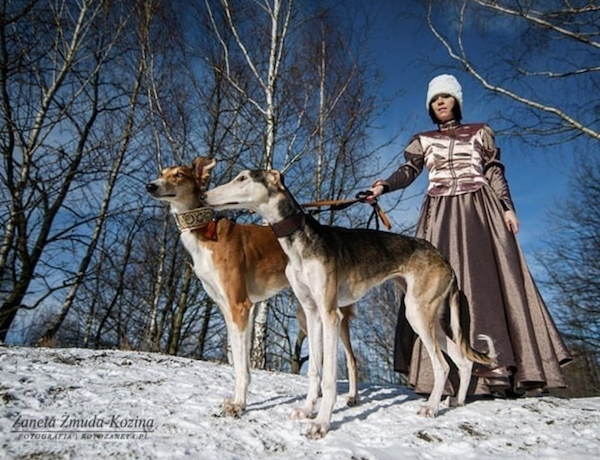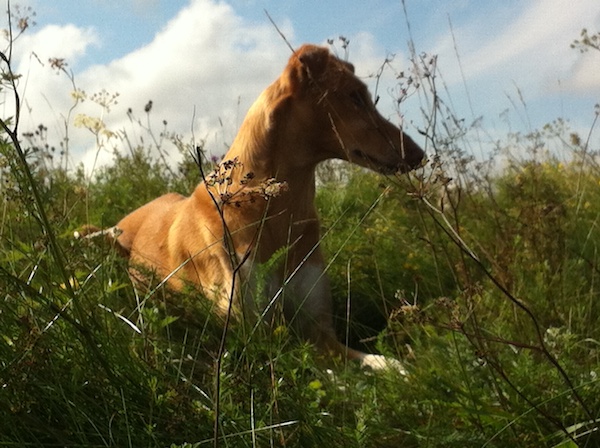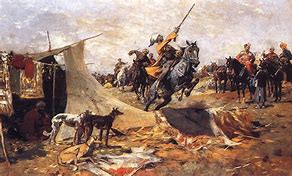
New as the breed may be to some of our readers, the Chart Polski is a very old breed, and its presence in Poland dates back to the 13th century, possibly earlier. Like many breeds, its origins are a complete mystery, in large part because the breed was developed long before people thought to keep written records of their dogs.
The first recorded mention of the breed is thought to have been in the book, “Riding and Hunting” by Polish writer Gostomski, the year: 1690. In it, the author gives a detailed description of the sighthound, including its hunting methods and how to care for one. Still, its earliest origins are subject to theory. Some think it descended from British Greyhounds imported to Poland, but one source points out that early Polish breeders considered the Chart Polski to be entirely separate from British Greyhounds, and from Russian and Hungarian ones, as well. The FCI standard says the Chart Polski goes back to Asiatic sighthounds, a suggestion supported by current thinking that Asiatic Sighthounds were probably the first group of dogs deliberately bred anywhere in the world. It’s known that historically, there was contact between Asia and Poland (especially if one gives credence to a Polish state having bordered China in the 17th century), but some feel there are similarities between the Chart Polski and Asiatic sighthounds that cannot be discounted, including its phenotype and temperament.
A favorite of Polish nobility and the privileged classes, the breed was used mostly as a hunting dog able to run down prey. Sadly, both wars wreaked havoc on the breed. At least 6 million Poles died during WWII, and the country’s economy essentially stopped. Most Chart Polskis were abandoned by their noble owners to become strays. Many were killed by radicals who saw the dogs as symbols of their own exploitation and repression.
Dogs that survived the purge wandered the countryside, often taken in by Polish peasants or middle class families who put them to work hunting game. What the dogs hunted was usually the only source of protein for a family, but in the end, it was a symbiotic relationship because had it not been for those people, the breed would likely have gone entirely extinct.
The breed saw a resurgence in the 1970s, in part because of an article on the breed written in 1972 by Dr. Mroczowski. The piece, which appeared in a popular Polish magazine, appealed to the Polish people to save their heritage by preserving their ancient Chart Polski. Individuals conscious of their cultural heritage became determined, and with the help of documentation, sighthound experts, and their own convictions, a stud book was opened for the breed in 1981. Thirty dogs were registered; some had been found by combing the Polish countryside for the best surviving examples of the breed, some were the descendents of old kennels, some had been brought in from Ukraine, and some puppies came from new breedings. In 1989, a standard was approved under FCI #333, a standard, one source writes, that was based not on the current dogs being used to revive the breed, but by depictions of what the breed looked like in paintings done by 19th century artists such as Jozef Brandt, Juliusz Kossak and Alfreda Wierusz-Kowalski:
The Polish Kennel Club recognized the breed in 1981, and eight years later, by the FCI. The United Kennel Club accepted the breed in 1996. The first Chart Polskis were imported into the United States by Kaz and Betty Augustowski.
Though hunting with dogs is banned in Poland, track racing is making the breed better known, if not popular. More people are discovering this breed as a lovely family dog, and thus, we’ve read that breed numbers are rising steadily in Poland.
Special shows often include the breed with owners dressed in authentic period clothing, and hunting simulations with a mechanized lure demonstrate the speed and beauty of the breed.

Photo of Katarzyna Rożko with two bitches, “REBELIA Celerrimus” and “PRZENIKLIWIE UROKLIWA Gradusmoka” taken by Żaneta Żmuda Kozina
Artwork by Jozef Brandt (1841 – 1915) kindly provided by Boguslawa Helberger




